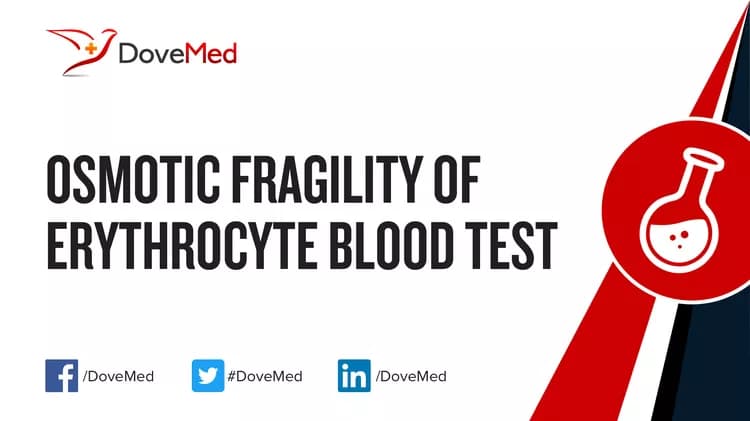What are other Names for this Test? (Equivalent Terms)
- Erythrocyte Osmotic Fragility Blood Test
- Osmotic Fragility of Red Blood Cells Blood Test
- Red Cell Fragility Blood Test
What is Osmotic Fragility of Erythrocytes Blood Test? (Background Information)
- Osmolality refers to the number of dissolved particles (solutes) in a fluid, in this case blood. Osmolality refers to concentration; it is reported in osmoles (Osm) per kilogram of blood
- Osmolality is similar to osmolarity, which measures the concentration of a compound in osmoles (Osm) per liter of total solution
- An osmole is a quantity of dissolved particles that contributes to the osmotic pressure of a solution. The greater the difference in osmolarity between two sides of a semipermeable membrane, the greater is the osmotic pressure
- Osmotic pressure causes a cell placed in salt water to shrink. This is because the higher osmolarity outside the cell relative to inside creates osmotic pressure directed towards outside the cell (i.e. the solution is hyperosmotic)
- If placed in a hypo-osmotic solution (in which the osmolarity of the solution is less than that of the inside of the cell), water will rush into the cell, causing it to swell and burst
- Importantly, the cell’s membrane is semi-permeable. It allows water to pass but not other molecules that are charged, polar, or too large
- The solutes in the body include electrolytes and non-electrolytes, such as sugars and proteins. Electrolytes are chemicals that dissociate in solution and conduct an electrical current. They are important to the body’s acid-base, electrical, and hydrostatic stability
- Electrolytes are mainly acquired through the diet. Major electrolytes include sodium (Na+), potassium (K+), chloride (Cl-), bicarbonate (HCO3-), and phosphate (HPO4 2-)
- Electrolytes are needed because they allow cells to regulate the flow of water across their membranes. This is called osmotic regulation. Osmotic regulation protects cells from bursting due to an influx of water if their surroundings lack salt
- The Osmotic Fragility of Erythrocytes Blood Test determines the red blood cells’ ability to resist destruction due to osmotic pressure in hypo-osmotic solutions. It is used to diagnose anemia and to determine the cause of anemia
- Red blood cells (erythrocytes) are placed in various hypo-osmotic solutions. If they burst in only slightly hypo-osmotic solutions, they have increased fragility. If they burst in stronger hypo-osmotic solutions, they have decreased fragility
What are the Clinical Indications for performing the Osmotic Fragility of Erythrocytes Blood Test?
Following are the clinical indications for performing the Osmotic Fragility of Erythrocytes Blood Test:
- Differentiating between various types of anemias
- Fatigue
- Paleness
- Shortness of breath
- Suspected toxicity
How is the Specimen Collected for Osmotic Fragility of Erythrocytes Blood Test?
Following is the specimen collection process for Osmotic Fragility of Erythrocytes Blood Test:
Sample required: Blood
Process of obtaining blood sample in adults:
- A band is wrapped around the arm, 3-4 inches above the collection site (superficial vein that lies within the elbow pit)
- The site is cleaned with 70% alcohol in an outward spiral, away from the zone of needle insertion
- The needle cap is removed and is held in line with the vein, pulling the skin tight
- With a small and quick thrust, the vein is penetrated using the needle
- The required amount of blood sample is collected by pulling the plunger of the syringe out slowly
- The wrap band is removed, gauze is placed on the collection site, and the needle is removed
- The blood is immediately transferred into the blood container, which has the appropriate preservative/clot activator/anti-coagulant
- The syringe and the needle are disposed into the appropriate “sharp container” for safe and hygienic disposal
Preparation required: No special preparation is needed prior to the test.
What is the Significance of the Osmotic Fragility of Erythrocytes Blood Test Result?
The significance of the Osmotic Fragility of Erythrocytes Blood Test result is explained.
- If red blood cells burst in only slightly hypo-osmotic (0.36% to 0.73%) solutions, they have increased osmotic fragility. This may indicate:
- Hereditary spherocytosis
- Hemoglobin C disease
- Chronic lymphocytic leukemia
- Transfusion acquired hemolytic anemia
- Chemical toxicity
- Thermal burns
- If red blood cells burst in severely hypo-osmotic solutions, they have decreased osmotic fragility. This may indicate:
- Anemia
- Thalassemia major and minor
- Hemoglobin C disease
- Polycythemia vera
- Acute and subacute necrosis of the liver
- Obstructive jaundice
The laboratory test results are NOT to be interpreted as results of a "stand-alone" test. The test results have to be interpreted after correlating with suitable clinical findings and additional supplemental tests/information. Your healthcare providers will explain the meaning of your tests results, based on the overall clinical scenario.
Additional and Relevant Useful Information:
- Certain factors interfere with the results of the Osmotic Fragility of Erythrocytes Blood test. These include hydration status, pregnancy, and consumption of electrolyte-rich foods
Certain medications that you may be currently taking may influence the outcome of the test. Hence, it is important to inform your healthcare provider of the complete list of medications (including any herbal supplements) you are currently taking. This will help the healthcare provider interpret your test results more accurately and avoid unnecessary chances of a misdiagnosis.
The following DoveMed website link is a useful resource for additional information:
http://www.dovemed.com/common-procedures/procedures-laboratory/osmolality-blood-test/
Please visit our Laboratory Procedures Center for more physician-approved health information:
http://www.dovemed.com/common-procedures/procedures-laboratory/
Related Articles
Test Your Knowledge
Asked by users
Related Centers
Related Specialties
Related Physicians
Related Procedures
Related Resources
Join DoveHubs
and connect with fellow professionals


0 Comments
Please log in to post a comment.